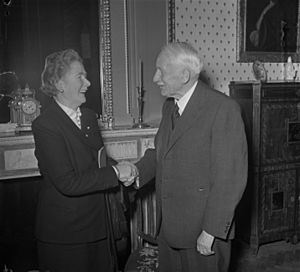Charley Toorop facts for kids
Quick facts for kids
Charley Toorop
|
|
|---|---|

Charley Toorop in 1903
|
|
| Born |
Annie Caroline Pontifex Fernhout-Toorop
24 March 1891 |
| Died | 5 November 1955 (aged 64) |
| Nationality | Dutch |
| Known for | painting, printmaking |
Charley Toorop (Dutch pronunciation: [ˈt͡ʃɑrliː ˈtoːrɔp]) was a famous Dutch painter and lithographer. She was born on March 24, 1891, and passed away on November 5, 1955. Her full name was Annie Caroline Pontifex Fernhout-Toorop. She is known for her unique and powerful paintings.
Contents
About Charley Toorop's Life
Charley Toorop was born in a town called Katwijk in the Netherlands. Her father, Jan Toorop, was also a well-known artist. In May 1912, Charley married a philosopher named Henk Fernhout. They later divorced in 1917.
Charley had two sons who also became artists. Her son Edgar Fernhout (1912–1974) followed in her footsteps and became a painter. Her other son, John Fernhout (1913–1987), became a filmmaker. He often worked with another famous filmmaker, Joris Ivens. John sometimes used the name John Ferno for his films. Charley's daughter-in-law, Eva Besnyö (1910–2003), was a well-known Jewish photographer who married John in 1933.
Charley Toorop lived in many different places throughout her life. From 1932 onwards, she lived in Bergen, North Holland. She had lived there before, from 1912-1915 and again from 1922–1926. In Bergen, she designed her own house called "De Vlerken." This house is still there today, though its roof was changed after a fire. Charley Toorop died in Bergen on November 5, 1955.
Charley Toorop's Art and Style
In 1916, Charley Toorop joined a group of artists called Het Signaal (The Signal). This group wanted to show a deep sense of reality in their art. They used strong colors and bold, clear lines. They also used sharp contrasts between colors. Because of this style, Toorop is often linked to the Bergense School, which was an art movement in the Netherlands.
Charley Toorop was friends with other important artists, like Bart van der Leck and Piet Mondriaan. In 1926, she moved to Amsterdam for two years. While living there, her painting style was influenced by films. She would paint figures standing alone, facing forward, almost as if they were lit up by movie lights on a film set. Her still life paintings, which show objects like fruit or flowers, were similar to the "synthetic cubism" style of artist Juan Gris.
One of her most famous paintings is a large work called Three Generations (Drie generaties). She painted it between 1941 and 1950. This painting is special because it shows herself, her father, and her son Edgar all together. In this artwork, she combined a realistic style with a deeper, symbolic meaning.
Charley Toorop's art is known for its "ruthless realism," meaning she painted things exactly as they were, but with a magical touch. She once wondered, "Is the natural appearance reality, or can we sense in its form only the most unreal that appears before us? This unreal, which is the most real." This shows how she thought deeply about what she saw and painted.
Where to See Charley Toorop's Art
You can find Charley Toorop's paintings in many public art collections. Some of the museums where her works are displayed include:
- Museum Boijmans van Beuningen in Rotterdam
- Museum Kranenburgh in Bergen, North Holland
- Kröller-Müller Museum in Otterlo
- Stedelijk Museum Alkmaar in Alkmaar
- Groninger Museum in Groningen
- Museum de Fundatie, Zwolle, The Netherlands
See also
 In Spanish: Charley Toorop para niños
In Spanish: Charley Toorop para niños


